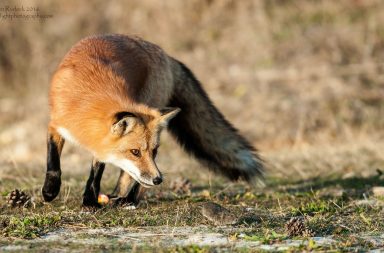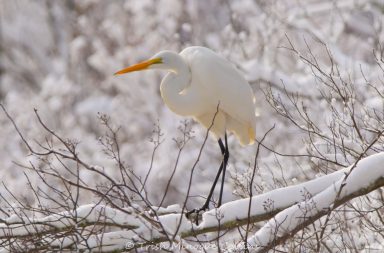AMERICAN BITTERN
A stealthily solitary bird of the marsh, the American Bittern is a fascinating but illusive and secretive bird. There are 16 different bitterns worldwide, but only two are found in North America; the American and the Least (we rarely see the Least here on LI). Bitterns have been confused with immature night herons; however, they rarely perch in trees like the night heron, preferring to stand in or near the water. Bitterns prefer freshwater marshes, cohabiting with birds like the Sora and Pied-billed Grebe.
The American Bittern has an almost pear-shaped body with a longish heavy dull yellow bill. The bird’s iris is yellow and the legs bright yellow to green. Feather coloration is a rusty cap on the top of the head, a brownish back with a white throat, striped brown and white all the way down the chest and sides and a blue/black patch on the sides and below the eye down along the neck. Males are slightly larger than females.
Courtship begins after females arrive on the breeding grounds in early March to early May. Male courtship involves feather fluffing and calling. Feather fluffing shows off white ruffs found on the sides and back; this is the basis for folklore that believes bitterns can project light from its body to find prey at night. The males will begin their calls with clicks and air gulping, inflating the esophagus and contorting their bodies to produce a “pump-er-lunk” or a “dunk-a-do” sound. The sound is often described as “driving a stake into mud with a wooden mallet”. Through history the American bittern has been called a “stake-driver,” ”thunder-pumper,” and “mire-drum” and has often been associated with evil because of these sounds; they were often thought to be a warning of doom and desolation. In early New England, bitterns were considered an “affront to the Sabbath” and in 1786 were hunted in large numbers for this reason.
The female builds the nest in the marsh and incubates the eggs. As the vegetation grows the nests become well hidden and are composed of reeds, sedges, cattails and are lined with fine grasses. Four to five eggs are laid with incubation being about 28 days and the young will remain in the nest for about two weeks. The female feeds the young regurgitated partially digested fish, frogs, snakes, mice, or crayfish.
The bittern is known mostly for its foraging and camouflaging behavior. The bird walks slowly and deliberately through the reeds, stopping and remaining perfectly still for long minutes, until prey appears at which time a lightening fast stab with the bill ends the hunt. If threatened the bittern will stand with its head straight up and blend with the surrounding reedy vegetation becoming virtually impossible to see. The eyes are set in the head so the bird can see up or down, depending on the head position, allowing them to remain in one position. If it is breezy or windy the bittern will move with the reeds, again fooling any predator or prey.
Bitterns may migrate in the fall as far south as Costa Rica and Panama but many go only as far as the South Atlantic coast, Georgia, Florida, Mississippi and Louisiana. Bitterns in our area have been reported along Dune Road in Hampton Bays and Jamaica Bay in Queens almost all year long. Not much is known about total population numbers but those numbers are dropping due to loss of habitat, with some effect from acid rain. They are listed as endangered in some states and “of special concern” in other states; however, populations are still strong in southern Canada.
So give a look-see when birding in marshy areas because you never know if those swaying reeds might really be an American Bittern in disguise.
Good Birding!
The photos below were all submitted by members of the Long Island Wildlife Photography Group on Facebook

Russ Ogden

Lelah Cafuoco

Grace Scalzo
More images on pages 2 and 3!



